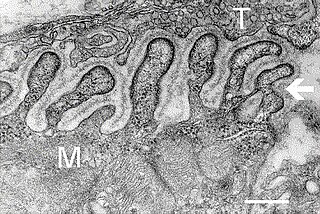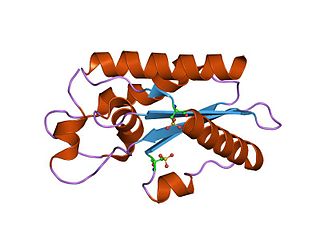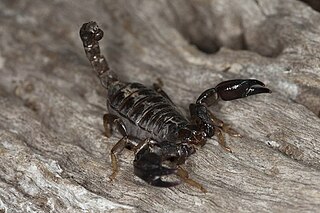Sources

Triflin is a toxin derived from snake venom. The toxin is produced in the gland of the Habu snake, Trimeresurus flavoviridis . [1]
Triflin is a cysteine-rich secretory protein (CRISP), which is excreted by the venom gland of the Habu snake ( Trimeresurus flavoviridis ). [1] Triflin reduces high potassium-induced smooth muscle contraction, suggesting a blocking effect on L-type calcium channels. [2]

Triflin is a toxin derived from snake venom. The toxin is produced in the gland of the Habu snake, Trimeresurus flavoviridis . [1]
Triflin is a cysteine-rich secretory protein, which means it belongs to the CRISP family. This is a group of single chain polypeptides found in various organisms. Triflin weighs 25 kDa and consists of 221 amino-acid residues. The first 163 residues of the N-terminal domain forms an α-β-α sandwich core. This domain is comparable with group 1 plant pathogenesis-related protein (PR-1). The C-terminal domain, has five disulfide bridges. This domain is responsible for the selectivity of the protein and consists of two subdomains: N-terminal subdomain (Cys 167 to Cys 179) and C-terminal subdomain (42 amino-acids residues). The N-terminal subdomain is connected with N-terminal domain through two main-chain hydrogen bonds between β11 and β2 and is thereby part of the PR-1 domain. The C-terminal subdomain is stabilized by three disulfide bridges and it is remarkable that this domain does not interact with either the PR-1 domain or the N-terminal sub-domain. The C-terminal subdomain consists of particles, including some hydrophobic residues that are exposed to the solvent. These hydrophobic residues might mediate the interaction with the target proteins and therefore receptor recognition. [1]
There are some homologous toxins to Triflin with different percentages of amino-acid sequence similarity, such as Ablomin, Latisemin, Stecrip (88%), Helothermine (49%), [2] Pseudechetoxin (62%), Pseudesin (61%). [3] The snake venoms which belong to CRISP family seem to be homologous to each other, however there are differences in their protein targets. [1]
Triflin reduces high potassium induced smooth muscle contraction, suggesting a blocking effect on L-type calcium channels. [2]
One of the small serum proteins (SSP-2), a substance produced by Trimeresurus flavoviridis itself, has high affinity for Triflin, and may thus work as a defensive mechanism against accidental self-poisoning, suggesting a possible role for SSP-2 as an antidote to triflin. [4]

A neuromuscular junction is a chemical synapse between a motor neuron and a muscle fiber.

A conotoxin is one of a group of neurotoxic peptides isolated from the venom of the marine cone snail, genus Conus.
Ophanin is a toxin found in the venom of the King Cobra, which lives throughout South East Asia. This toxin belongs to the cysteine-rich secretory protein (CRISP) family. Ophanin weakly blocks the contraction of smooth muscles elicited by high potassium-induced depolarization, suggesting that it inhibits voltage-dependent calcium channels.

Gloydius blomhoffii, commonly known as the mamushi, Japanese moccasin, Japanese pit viper, Qichun snake, Salmusa or Japanese mamushi, is a venomous pit viper species found in Japan. It was once considered to have 4 subspecies, but it is now considered monotypic.

Calciseptine (CaS) is a natural neurotoxin isolated from the black mamba Dendroaspis p. polylepis venom. This toxin consists of 60 amino acids with four disulfide bonds. Calciseptine specifically blocks L-type calcium channels, but not other voltage-dependent Ca2+ channels such as N-type and T-type channels.

Slotoxin is a peptide from Centruroides noxius Hoffmann scorpion venom. It belongs to the short scorpion toxin superfamily.
Ablomin is a toxin present in the venom of the Japanese Mamushi snake, which blocks L-type voltage-gated calcium channels.
BmKAEP is a neurotoxin from the venom of the Manchurian scorpion (Mesobuthus martensii). It is a β-toxin, which shift the activation voltage of sodium channels towards more negative potentials.
Piscivorin is a component of snake venom secreted by the Eastern Cottonmouth. It is a member of the cysteine-rich secretory protein (CRISP) family, which blocks voltage-dependent calcium channels.
Latisemin is a cysteine-rich secretory protein that can be isolated from the venom of the Black-banded sea krait, a sea snake indigenous to the warmer waters of the western Pacific Ocean. It is a toxin that inhibits cyclic nucleotide-gated ion channels and blocks L-type calcium channels, thereby reducing smooth muscle contraction.

Cysteine-rich secretory proteins, often abbreviated as CRISPs, are a group of glycoproteins. They are a subgroup of the CRISP, antigen 5 and Pr-1 (CAP) protein superfamily and also contain a domain related to the ShK toxins. They are substantially implicated in the functioning of the mammalian reproductive system. CRISPs are also found in a variety of snake venoms where they inhibit both smooth muscle contraction and cyclic nucleotide-gated ion channels.

The CAP superfamily is a large superfamily of secreted proteins that are produced by a wide range of organisms, including prokaryotes and non-vertebrate eukaryotes.
Huwentoxins (HWTX) are a group of neurotoxic peptides found in the venom of the Chinese bird spider Haplopelma schmidti. The species was formerly known as Haplopelma huwenum, Ornithoctonus huwena and Selenocosmia huwena. While structural similarity can be found among several of these toxins, HWTX as a group possess high functional diversity.
Atrolysin A is an enzyme that is one of six hemorrhagic toxins found in the venom of western diamondback rattlesnake. This endopeptidase has a length of 419 amino acid residues. The metalloproteinase disintegrin-like domain and the cysteine-rich domain of the enzyme are responsible for the enzyme's hemorrhagic effects on organisms via inhibition of platelet aggregation.
Trimerelysin I is an enzyme. This enzyme catalyses the following chemical reaction

Three-finger toxins are a protein superfamily of small toxin proteins found in the venom of snakes. Three-finger toxins are in turn members of a larger superfamily of three-finger protein domains which includes non-toxic proteins that share a similar protein fold. The group is named for its common structure consisting of three beta strand loops connected to a central core containing four conserved disulfide bonds. The 3FP protein domain has no enzymatic activity and is typically between 60-74 amino acid residues long. Despite their conserved structure, three-finger toxin proteins have a wide range of pharmacological effects. Most members of the family are neurotoxins that act on cholinergic intercellular signaling; the alpha-neurotoxin family interacts with muscle nicotinic acetylcholine receptors (nAChRs), the kappa-bungarotoxin family with neuronal nAChRs, and muscarinic toxins with muscarinic acetylcholine receptors (mAChRs).
Azemiopsin, a toxin obtained from the Azemiops feae viper venom, is a polypeptide that consists of 21 amino acid residues. It does not contain cysteine residues or disulfide bridges. The polypeptide can block skeletal muscle contraction by blocking nicotinic acetylcholine receptors.

Wasabi receptor toxin (WaTx) is the active component of the venom of the Australian black rock scorpion Urodacus manicatus. WaTx targets TRPA1, also known as the wasabi receptor or irritant receptor. WaTx is a cell-penetrating toxin that stabilizes the TRPA1 channel open state while reducing its Ca2+-permeability, thereby eliciting pain and pain hypersensitivity without the neurogenic inflammation that typically occurs in other animal toxins.
Intrepicalcin (ViCaTx1) is a short peptide toxin found in the venom of scorpion Vaejovis intrepidus. It is one of a group of short, basic peptides called calcins, which bind to ryanodine receptors (RyRs) and thereby trigger calcium release from the sarcoplasmic reticulum.

LmKTT-1a is a bifunctional Kunitz-type toxin belonging to the ẟ-KTx subfamily, found in the venom of Lychasmucronatus. As a bifunctional toxin, it has an inhibitory effect on trypsin activity and a blocking function on Kv1.3 channels with low selectivity.